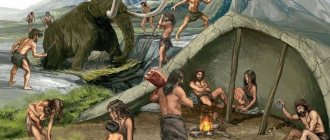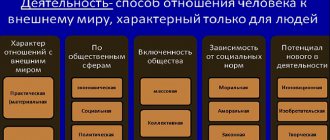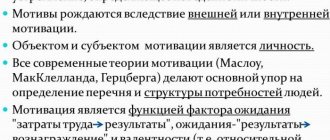Modern psychological science is based on such basic concepts as “personality”, “consciousness”, “activity”, “communication”. Often the concept of activity in psychology is interpreted as a unique form of the subject’s relationship to the world around him. Moreover, this attitude is conscious, aimed at its development and transformation to the extent that it seems appropriate to the individual. The role of consciousness depends on the type of activity - in scientific, work or play, its psychological component is different.
Activity is recognized as the basis for personality formation.
Articles on the topic
- What is professional stress, its main signs and types 08/29/2021
- Self-analysis and self-assessment of a teacher’s professional activity as the main criteria for his work 08/13/2021
- What is the role of self-esteem in choosing a profession 08/13/2021
- What does success in business depend on and how not to lose it 07/12/2021
A purposeful attitude towards the world is realized in the following types: cognitive, evaluative, spiritual or material, reproductive, creative and many others.
What it is
Activity is a form of human activity aimed at cognition, transformation of the surrounding world, oneself and the conditions of one’s existence. This is what distinguishes man from animals and emphasizes the social in human nature.
- Activities are not limited to meeting needs.
- It is determined by the goals and requirements of society.
- Actions are associated with the development of personality and human consciousness (including self-awareness).
- This is a consciously regulated process of human interaction with the world.
In activity, a person acts as a creator, creator. In its process, the following develop:
- intellectual abilities of the individual;
- creative imagination;
- worldview;
- system of ideals and values;
- emotional and aesthetic attitude to the world.
As a member of society, a person is valuable when he leads an active working and social life, commits actions and bears responsibility for them.
Subject of activity
Activity is always objectified. The subject is what it is aimed at. It can exist independently or be created in the process of the activity itself.
Operating principles
The activity is based on the principle of functionality and the principle of consistency.
- The first involves relying on already developed mental elements that are mobilized to achieve a goal.
- The principle of systematicity presupposes the inclusion of individual personality traits, on the basis of which several blocks in the structure can be identified.
Activity structure
Six blocks can be distinguished. Each of the elements is interconnected with others, interpenetrating.
Motives
This is where needs come into play. A motive is an objectified need. The desire to satisfy a need, that is, to obtain a specific item, encourages activity. Activity is impossible without motive.
Goals
Main element. It has two forms of manifestation:
- as a result represented by a person;
- as the desired level of achievement.
Program
A person decides what and how he should do, that is, it is a choice of methods and means, an assessment of his own resources. The work includes the cognitive, motivational, and executive spheres.
Information base
Its effectiveness depends on the adequacy and completeness of information about the conditions of activity.
Making decisions
One is selected from the alternative options, mastered, and rules and criteria for achieving the goal are developed.
Personal qualities that are significant for activities
These are character traits, abilities, inclinations and other individual characteristics that will help you achieve your goal.
Activity Components
Activity always has an internal plan and an external manifestation, between which there is an inextricable connection. From external operations with objects (objective thinking), information, transformed by the psyche, turns into internal images, ideals (imaginative thinking). The process of such a transition is called internalization.
The reverse action (creating something materially through internal representations) is exteriorization.
Action is a tool to achieve a goal
Action is a part of an activity aimed at achieving an intermediate result in specific conditions. Consists of operations - methods of execution according to conditions.
Physical actions
These are external, motor actions with objects that consist of movements.
Intelligent Actions
Internal mental actions with images and concepts based on external actions with objects.
Psyche – regulator of activity
The reflection of the world by the psyche occurs consciously, that is, in the process of actions a person:
- is aware (partially or fully) of the purpose of his actions;
- represents the result;
- perceives and evaluates the conditions in which one has to act;
- builds a step-by-step plan, an algorithm of operations;
- makes volitional efforts;
- observes the process;
- experiences successes and failures.
History of study and followers
A. Bernstein and P. Anokhin managed to identify general patterns. Psychologists studied the organization of movements, brain activity aimed at movement. This served as the basis for the creation of the theory of functional systems, which explains the structure of goal-directed activity.
According to the theory, goal-directed activity should consist of sequential elements. The motivation to initiate action is a perceived need.
For the first time, a description of the motif is found in the works of K. Obukhovsky, V. Kovalev. They conducted a series of experiments that showed that motive influences an individual's willingness to perform a purposeful action. Lack of motive is the reason for refusing to act.
Knowledge, abilities, skills, habits
Knowledge, abilities, skills, or KUN – the basis responsible for organizing and managing practical activities.
Knowledge
These are images of sensations and perceptions, later processed into ideas and concepts. Without them, conscious, purposeful activity is impossible. Knowledge increases the effectiveness of actions.
Skills
This is mastery of a method of performing an action that does not require reinforcement with exercises. Conscious individual control is the main difference between skills. They are closely related to thinking and are impossible without active intellectual activity. Skills allow you to find a way out of non-standard situations and respond to changes in external conditions.
Skills
Skills are actions brought to automaticity. The success of an activity depends on skills. Skills are formed through exercise - repeated repetition of a specific action (actions). The skill is based on a dynamic stereotype, that is, a neural connection between the elements of the action. This happens uncontrollably, but if any inaccuracy occurs, the person immediately notices it. The stronger the nerve connection, the faster and better the action.
Skills can be motor, thinking, sensory, behavioral. The skill is formed in several stages:
- introductory (comprehension of actions, familiarization with implementation techniques);
- preparatory (conscious but inept execution of an action);
- standardizing (unity and automaticity of actions);
- situational (mastery of arbitrariness of action).
Learning new skills is always influenced by old ones. Sometimes this helps, and sometimes it hinders. In the first case we are talking about coordination of skills, in the second – about interference (contradiction). Skills are aligned when:
- the movement system of one skill coincides with the movement system of another;
- one skill is a means of better mastering another;
- the end of one skill is the beginning of another and vice versa.
Accordingly, interference occurs under the opposite conditions.
Habits
A habit is an action that has become a need. Habits can be positive and negative. Habits, like skills, are based on dynamic stereotypes. Habits are formed through:
- imitation;
- multiple random repetitions;
- conscious, goal-directed learning.
They can be a driving force or a braking factor when performing an activity.
Study methods
The phenomenon was studied by domestic and foreign psychologists. Commonly accepted theories:
- Theory of S. Rubinstein. Activity is subject to external conditions. It is indivisible with consciousness and has a complex structure. To adapt to external conditions, a person must regulate behavior. A person learns control. At the same time, the connection between actions and consciousness develops.
- Theory of A. Leontiev. The researcher believed that internal activity is the transition of an external mental process into an internal one. A person with hearing loss can reproduce a sound in their mind even though they cannot hear it. Activity is a complex of operations that arose during the development of consciousness.
- Theory of L. Vygotsky. He considered activity as a result of the work of higher mental functions. Among primitive people, higher mental functions formed relationships between people, but were transformed into mental phenomena.
Since activity is a complex process, its study is possible only with the use of practical experiments and computer technology. This is a significant question for research in psychology, sociology, philosophy, biology and other sciences. Research results can change the idea of a person and their place in the world around them.
Activities
There are many types of activities, but in psychology it is customary to distinguish 4 main ones.
Communication
Communication is the first activity in which a person participates (intimate-personal communication with the mother). In this form of activity the first development of personality occurs.
The purpose of communication is to establish mutual understanding, personal and business relationships, provide mutual assistance, and the educational influence of people on each other.
It is worth noting that some researchers do not consider communication to be an independent activity, but rather call it a means for implementing other activities, achieving the goals of other activities. However, in infancy this species is the leading one.
A game
Play is the main activity of childhood, but it continues at subsequent age stages. Allows you to assimilate the social experience of human activity and human relationships. For adults, play is relaxation and stress relief.
Play activities prepare a person for further education and work. She develops:
- thinking,
- memory,
- imagination,
- attention,
- capabilities,
- will.
It also determines the formation of character.
Studies
Educational activities were separated from work activities. Assumes:
- assimilation of information about the properties of the surrounding world (knowledge), techniques, operations (skills);
- development of the ability to choose techniques and operations in accordance with goals and conditions (skills).
In educational activities, knowledge is acquired, skills and abilities are developed, and abilities are developed.
Work
Labor is an activity aimed at creating a socially significant product. Labor is the basis of human existence, his mental and personal development.
There are other types of activities, but they are all built within the framework of one of the four named or at the junction of several types. The choice depends on the strength, quantity, and uniqueness of the needs of a particular person.
However, at every age, a person performs several types of activities at once, and only one remains the leader. For example, for an adult it is work.
Main spheres of society's life
Any type of human activity (work, play, communication, etc.) can take place in any area.
There are traditionally four such areas:
:
- Social
– peoples, classes, gender and age groups, etc. - Economic
– production relations, productive forces. - Political
– the state, parties, socio-political organizations. - Spiritual
- religion, morality, education, art, science.
In this case, each person is affected simultaneously by all four spheres. Each of us belongs to a certain nation, social class, has a certain age and gender, enters into economic relations, has a certain level of education and a certain worldview.
However, not all types of human activity in each of the spheres are equivalent. Thus, in the spiritual sphere, science occupies a dominant position, its “reflections” are education and art; morality depends on the level of collective awareness of society, and religion is a consequence of an extremely low level of this same awareness. The nature of social activity can change over time: in one era the average person can work for the prosperity of his nation, in another his work can be aimed at meeting the needs of all humanity as a whole, because there is no division into peoples and nations.
Individual style of activity
This is an adaptation of the human nervous system and body characteristics to the activity being performed. The basis of individual style is:
- human temperament;
- skills;
- skills;
- experience.
The purpose of such a device is to achieve the best result at the lowest cost. Temperament determines the success and failure of a person in a specific activity.
Differences from activity
Gestalt psychology - what is it in psychology briefly
Not every interaction with the environment is called an activity. Activity is a broader concept; it can describe physical, intellectual and other types of work of the body.
Activity in animals is subordinated to the satisfaction of instincts
Activity is always conscious and has a specific goal. It is believed that it is inherent only to people; animals are not capable of such organization of behavior.
Afterword
Conscious purposeful activity is the difference between people and animals. In its process, a person creates objects of material and spiritual culture, transforms his abilities, ensures progress (although sometimes regression) of society, influences nature (preserves or destroys).
Any activity is a creative way beyond the natural, work on oneself and the world. Man not only consumes, but also creates. With her help he influences his life.
Thanks to it, the mental development of the individual is carried out. However, at the same time, mental processes (perception, attention, imagination, memory, thinking, speech) act as components and even separate types of activity.
Concept and essence
Primitive man sought to understand and transform the world around him.
At first he came into contact with nature, animals, and inanimate objects. As I developed, I learned to create, change objects, and transform nature. Activities are a controversial, little-studied topic. They began to pay active attention to it in the middle of the 20th century. A. Leontyev defined it as the process of satisfying the needs of the subject. For Soviet psychologists, it was not the activity itself that was important, but the mental processes based on it.
The term “activity” should be distinguished from the synonyms “movement” and “activity”. These terms describe the movement of matter. To describe the properties of inanimate matter, the term “motion” must be used.
The appearance of living matter caused the emergence of a new form of movement - activity. The actions that animals perform to maintain existence should be called life activities. The activity of an individual with awareness can be called full-fledged activity.
Some psychologists believe that highly organized animals also have the ability to engage in conscious activity. Primates, in addition to the actions necessary for survival, have the ability to play.
Principles of correctional and developmental education for children with mental retardation
The psychological characteristics of children with mental retardation lead to their failure at school. The knowledge acquired by students with mental retardation in a general education school does not meet the requirements of the school curriculum. Particularly poorly mastered (or not mastered at all) are those sections of the program that require significant mental work or consistent multi-stage establishment of relationships between the objects or phenomena being studied. Consequently, the principle of systematic learning, which provides for children with mental retardation to master the fundamentals of science in the form of a system of knowledge, skills and abilities, remains unrealized. The principle of consciousness and activity in learning remains equally unrealized for them. Children often memorize certain rules, regulations, laws mechanically and therefore cannot apply them when working independently.
When performing written work, mistakes in the actions necessary for the correct completion of the task, which are very typical for children in this category, are revealed. This is evidenced by the numerous corrections made by the child as he works, the large number of errors that remain uncorrected, the frequent violation of the sequence of actions and the omission of individual parts of the task. Such shortcomings in many cases can be explained by the impulsiveness of such students and the insufficient development of their activities.
The low level of educational knowledge serves as evidence of the low productivity of education of children of this group in a comprehensive school. But the search for effective teaching tools must be carried out not only in connection with the development of techniques and methods of work that are adequate to the developmental characteristics of such children. The content of training itself should acquire a correctional orientation.
It is known that a normally developing child begins to master mental operations and methods of mental activity already in preschool age. The lack of formation of these operations and methods of action in children with mental retardation leads to the fact that even at school age they find themselves tied to a specific situation, due to which the acquired knowledge remains scattered and is often limited to direct sensory experience. Such knowledge does not ensure the full development of children. Only when brought into a single logical system do they become the basis for the student’s mental growth and a means of activating cognitive activity.
An integral part of remedial education for children with mental retardation is the normalization of their activities, and in particular educational activities, which are characterized by extreme disorganization, impulsiveness, and low productivity. Students in this category do not know how to plan their actions and control them; They are not guided in their activities by the ultimate goal, they often “jump” from one thing to another without completing what they started.
Impaired activity in children with mental retardation is a significant component in the structure of the defect; it inhibits the child’s learning and development. Normalization of activity is an important part of the correctional education of such children, which is carried out in all lessons and outside of school hours, but overcoming some aspects of this disorder may be the content of special classes.
6 pages, 2694 words
social adaptation and integration into society of children with different...
… 15.58] The main objectives of teaching and raising children in special (correctional) educational institutions of the VIII type are the correction of developmental deviations by means of education and labor... the process of counseling and correction of the emotional states of children. Experimental base: GBOU Belokatayskaya special (correctional) general education boarding school of the VIII type Work structure: ...
Thus, a number of characteristics of children with mental retardation determine the general approach to the child, the specifics of the content and methods of correctional education. Subject to specific learning conditions, children in this category are able to master educational material of considerable complexity, designed for normally developing students in general education schools. This is confirmed by the experience of teaching children in special classes and the success of the subsequent education of most of them in general education schools.











